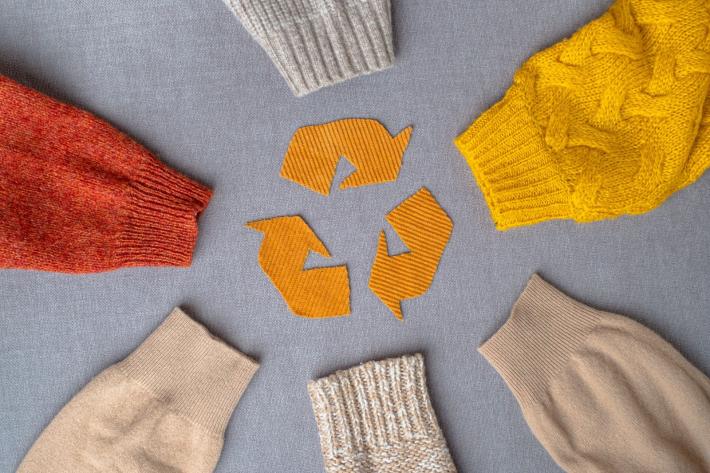How to make your wardrobe more sustainable?
29 March 2022

The hidden impact of fashion
The fashion industry accounts for 10% of global carbon emissions, is the second-largest consumer of the world’s water supply and pollutes the ocean with microplastics. While the environmental impact of activities such as flying is well known, clothing items have a carbon impact throughout their lifetime from production, use and disposal. Closer to home, Zero Waste Scotland found textiles make up just 4% of waste by weight but accounted for 32% of Scotland’s carbon impact.
Clothing not only has an impact on carbon emissions but puts stress on limited resources such as water. Natural materials aren’t necessarily sustainable, as they need vast amounts of water, dye, and transport. A single pair of jeans is estimated to use a kilogram of cotton. Cotton is grown in dry environments; a kilo would need around 10,000–20,000 litres of water, depending on where it is grown. Organic cotton may be better for the farmworkers who would otherwise be exposed to massive levels of pesticides, but lots of water is still needed.
To avoid the wide-ranging impacts our clothing has on the natural environment, and you can do many simple things to help change the way you buy clothes and reduce your impact on the planet. Here are just a few questions to ask when thinking more sustainable about your clothes.
1. How can I repurpose what I already have?
In the UK, we buy more clothing per head than any other country in Europe with over two tons of clothing bought each minute. By looking at your wardrobe, drawers and any clothes you have hidden away, to understand what you already own. Think how you could wear that top – dress it up or down with different trousers and jackets and give it a new look.
Trends tend to come and go, so always save items that you’ve become bored of in bags or boxes, to bring out later.
2. Will I wear this more than once?
According to the Evening Standard, one in 10 people would discard a piece of clothing after being pictured on social media wearing it three times. Try and avoid getting into the fast fashion trends, and buy items that are made of high-quality, durable material if you can. The ultimate test when out shopping is would you wear it 30 times?
Swap buying a statement piece you know you will only wear once and invest in something you can wear more often. Having versatile pieces that you can wear in different ways can help keep your style looking fresh and save the temptation to buy a new item.
3. Can I buy it second-hand?
Charity shops and online marketplaces are great ways to help save money. They extend the lifecycle of clothes, but they also protect the planet’s resources and reduce the demand for fast fashion.
There are more second-hand and vintage options now, with sites and apps such as Revolve Reuse, Vestiaire Collective and Depop helping people access clothes, giving you the chance to find a rare gem.
4. Will I need to return it?
As shopping online has increased, so too has fast fashion culture, with people buying more than they need, having it delivered and then returning most of their orders after trying them on. According to the BBC, 5 billion pounds of waste is generated through returns, with companies not having the infrastructure to process returns and choosing to dump them instead.
We can change this behaviour and reduce our carbon footprint by ordering what we want and intend to keep.
5. How do I make it last longer?
In the UK, wearing a garment for just nine months longer could reduce its environmental impact by 20–30%. Re-styling a piece of clothing and mixing up the combinations of garments can help refresh your look and add more life to your clothes. If your item is damaged, then repairing your clothes can help them last longer, and there are lots of great tips on how to do this by websites such as Love Your Clothes, set up by UK recycling charity WRAP.
Reducing how often you wash your clothes and letting them air instead is also a great way to make your clothes last longer, save water and stop plastics going into the water system.
6. Can I rent it or borrow it from a friend?
If you’ve been eyeing up your friend’s dress, why not ask if you can borrow it sometime? Swapping clothes with friends is an easy and fun way to immediately refresh your wardrobe when you get bored of your clothes. Try it out once every couple of months and have clothes swapping day with friends.
Rental fashion has been on the up for a few years now and is another simple way to have a new outfit without the pressure of keeping it. Approximately 206456 tonnes of textile waste in the UK is produced each year, with 1.7kg of textile waste per person going to landfills each year. Sharing our wardrobes and contributing to the circular economy is a step toward a more sustainable future.